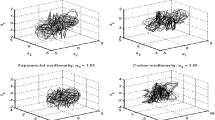Abstract
In this paper, we present a new system of weak signal detection based on Duffing oscillator with adjustable frequency, in which the frequency of periodic driving force signal can be fixed at a certain value and make the system to be in a same critical chaotic state. Therefore, by adjusting an adjustable signal frequency, the detection system we propose can detect signals of different frequencies in the same critical chaotic state, and overcome the limitation of the previous system which can only detect a signal of a specific frequency in a critical chaotic state. Meanwhile, we analyzed its system performance according to simulation and designed the circuit of the system. Based on the results of simulation and actual condition, we find the system is effective for weak signal detection. We can also find that in the proposed system, the signal detection accuracy increases firstly and then decreases with the increase in amplitude of adjustable signal, while the input noise variance is fixed. In addition, in the improved system, the smaller the variance of the input noise is, the higher the detection accuracy is, and the wider the adjustable operating range is.
Similar content being viewed by others
References
Huang Y, Liu F, Wang Z Z, et al. Perildic FRFT-based LFMCW signal detection and estimation (in Chinese). Sci Sin Inform, 2014, 44: 498–510
Duan S K, Hu X F, Wang L D, et al. Analog memristive memory with applications in audio signal processing. Sci China Inf Sci, 2014, 57: 042406
Quan Z, Cui s, Poor H V, et al. Collaborative wideband sensing for cognitive radio. IEEE Signal Process Mag, 2008, 25: 60–73
Liang G L, Ma W, Wang Y L. Time-space transform: a novel signal processing approach for an acoutic vector-sensor. Sci China Inf Sci, 2013, 56: 042313
Luo Y, Wang Y Q, Wu S L, et al. Multipath effects on vector tracking algorithm for GNSS signal. Sci China Inf Sci, 2013, 57: 102312
Kay S. Wavelet de-noising techniques with power spectral density to vibration signal. IEEE Trans Signal Process, 1999, 47: 10–21
Marano S, Matta V, Willett P. Sequential detection of almost-harmonic signals. IEEE Trans Signal Process, 2003, 51: 395–406
Zhang W, Guo J R, Xiang B R. Improving the detection sensitivity of chromatography by stochastic resonance. Analyst, 2014, 139: 2099–2107
Chang Y, Hao Y, Li C W. Phase dependent and independent frequency identification of weak signals based on Duffing oscillator via particle swarm optimization. Circuits Syst Signal Process, 2014, 33: 223–239
Vahid R, Mohsen N. Detecting the state of the duffing oscillator by phase space trajectory auto-correlation. Int J Bifurcat chaos, 2013, 23: 1350065
Deng X Y, Liu H B, Long T. A new complex Duffing oscillator used in complex signal detection. Chin Sci Bull, 2012, 57: 2185–2191
Rashtchi V, Nourazar M, Aghmasheh R. Fault diagnosis of broken bars in Squirrel-Cage induction motors using Duffing oscillators. Int Rev Electr Eng-I, 2012, 7: 4457–4468
Rashtchi V, Nourazar M. A multiprocessor nios II implementation of duffing oscillator array for weak signal detection. J Circuit Syst Comp, 2014, 23: 1450054
Fan J, Zhao W L. Study on the weak sinusoidal signal detection property using Duffing chaos system (in Chinese). Acta Phys Sin, 2013, 62: 46–51
Wang Y S, Jiang W Z, Zhao J J. A new method of weak signal detection using Duffing oscillator and its simulation research (in Chinese). Acta Phys Sin, 2008, 57: 2053–2059
Nie C Y. Chaotic system and weak signal detection (in Chinese). Dissertation for Doctoral Degree. Beijing: Tsing-hua University, 2009. 35–40
Beltran-Carbajal F, Silva-Navarro G. Active vibration control in Duffing mechanical systems using dynamic vibration absorbers. J Sound Vib, 2014, 333: 3019–3030
Li Y, Shi Y W. Chaotic detection method for weak square wave signal submerged in colored noise (in Chinese). Acta Electron Sin, 2004, 32: 87–90
Liu H B, Wu W D. A new weak sinusoidal signal detection method based on Duffing oscillators (in Chinese). Acta Electron Sin, 2013, 41: 8–12
Jin T, Zhang H. Statistical approach to weak signal detection and estimation using Duffing chaotic oscillators. Sci China Inf Sci, 2011, 54: 2324–2337
Xu Y C, Yang C L. A new approach to detecting weak signal in strong noise based on chaos system control. Chin Phys B, 2012, 19: 030516
Wang J G, Zhou J Z, Peng B. Weak signal detection method based on Duffing oscillator. Kybernetes, 2009, 38: 1662–1668
Author information
Authors and Affiliations
Corresponding authors
Rights and permissions
About this article
Cite this article
Ma, S., Lu, M., Ding, J. et al. Weak signal detection method based on Duffing oscillator with adjustable frequency. Sci. China Inf. Sci. 58, 1–9 (2015). https://doi.org/10.1007/s11432-015-5344-4
Received:
Accepted:
Published:
Issue Date:
DOI: https://doi.org/10.1007/s11432-015-5344-4




